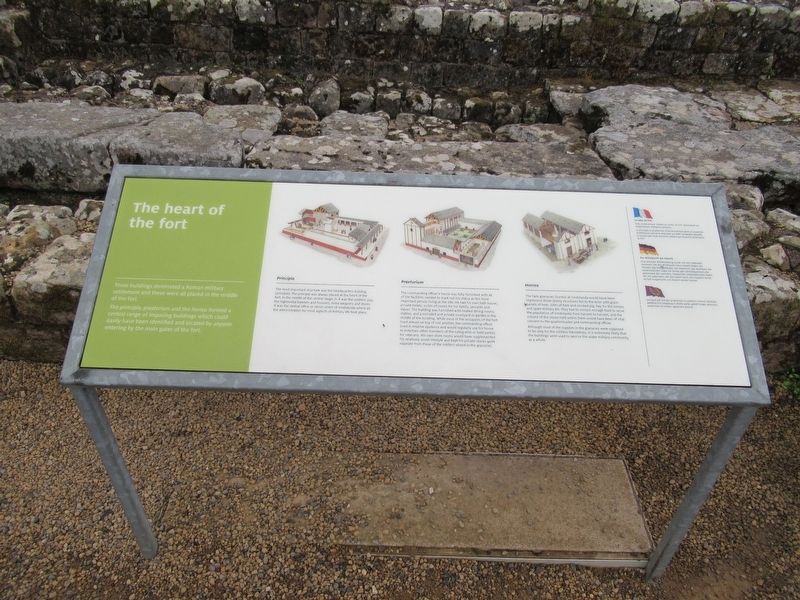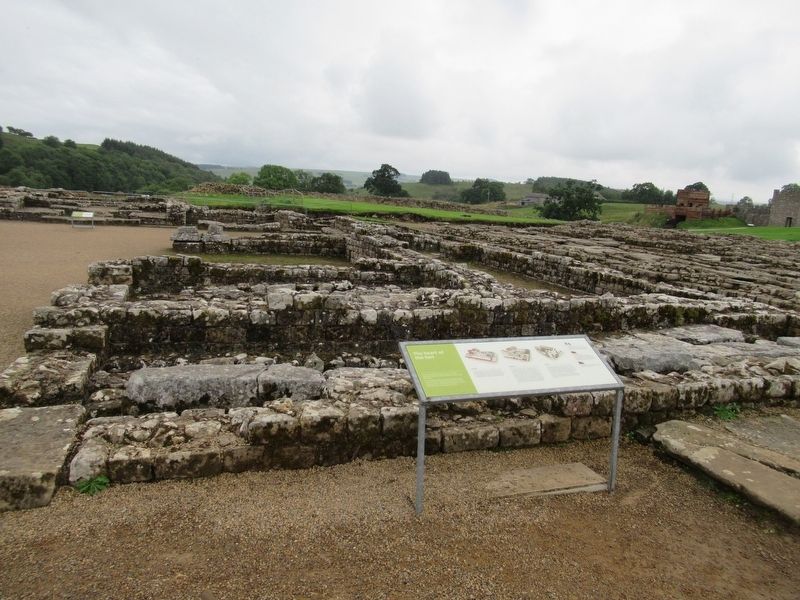Hexham in Northumberland, England, United Kingdom — Northwestern Europe (the British Isles)
The heart of the fort
Three buildings dominated a Roman military settlement and these were all placed in the middle of the fort. The principia, praetorium and the horrea formed a central range of imposing buildings which could easily have been identified and located by anyone entering by the main gates of the fort.
Principia
The most important structure was the headquarters building (principia). The principia was always placed at the heart of the fort, in the middle of the central range: in it was the soldiers' pay the regimental banners and honours, extra weapons and stores. It was the central office or nerve centre of Vindolanda where all the administration for most aspects of military life took place.
Praetorium
The commanding officer's house was fully furnished with all of the facilities needed to mark out his status as the most important person living at the site. He had his own bath house, private toilets, suites of rooms for his family, servants and slaves. The building was furnished with heated dining rooms, stables, and a secluded and private courtyard or garden in the middle of the building. While most of the occupants of the fort lived almost on top of one another, the commanding officer lived in relative opulence and would regularly use his house to entertain other members of the ruling elite or hold parties for veterans. His own store rooms would have supplemented his relatively lavish lifestyle and kept his private stocks quite separate from those of the soldiers stored in the granaries.
Horrea
The twin granaries (horrea) at Vindolanda would have been impressive three-storey structures full to the brim with grain, barrels of beer, sides of ham and smoked pig, hay for the horses and spare military kit. They had to contain enough food to serve the population of Vindolanda from harvest to harvest, and the volume of the stores held within them would have been of vital concern to the quartermaster and commanding officer. Although most of the supplies in the granaries were supposed to be only for the soldiers themselves, it is extremely likely that the buildings were used to service the wider military community as a whole.
Topics. This historical marker is listed in these topic lists: Forts and Castles • Settlements & Settlers.
Location. 54° 59.468′ N, 2° 21.725′ W. Marker is in Hexham, England, in Northumberland. Marker can be reached from road 68, 2.5 kilometers north of England Route A69, on the left when traveling north. Located at Vindolanda Roman fort and village archaeological site. Touch for map. Marker is in this post office area: Hexham, England NE47 7JN, United Kingdom. Touch for directions.
Other nearby markers. At least 8 other markers are within walking distance of this marker. A military community (a few steps from this marker); The village and fort (within shouting distance of this marker); North West Quadrant Barracks (within shouting distance of this marker); Beneath the soil (within shouting distance of this marker); The Severan fort (within shouting distance of this marker); Severan Circular Huts (within shouting distance of this marker); Workshops (about 120 meters away, measured in a direct line); Dolichenum (about 150 meters away). Touch for a list and map of all markers in Hexham.
Also see . . . Vindolanda on Wikipedia. (Submitted on November 15, 2018, by Michael Herrick of Southbury, Connecticut.)
Credits. This page was last revised on January 27, 2022. It was originally submitted on November 15, 2018, by Michael Herrick of Southbury, Connecticut. This page has been viewed 79 times since then and 5 times this year. Photos: 1, 2. submitted on November 15, 2018, by Michael Herrick of Southbury, Connecticut.

